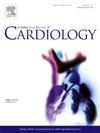FFRCT对心肌血运重建结果的有利影响:来自现实世界观察性登记的结果
IF 3.2
2区 医学
Q2 CARDIAC & CARDIOVASCULAR SYSTEMS
引用次数: 0
摘要
冠状动脉计算机断层血管造影(CCTA)衍生的分流储备(FFRCT)策略显著减少不必要的侵入性冠状动脉造影,并改进了血运重建决策的适当性。本研究旨在评估FFRCT引导策略如何影响血管化后的结果。方法纳入2013年至2021年疑似阻塞性冠状动脉疾病(OCAD)患者。FFRCT于2017年进入Heart-Team decision。倾向评分校正Cox和logistic回归分析FFRCT对血运重建术后主要不良心血管事件(MACE)和心肌损伤(PMI)的影响。结果7541例患者中,1601例疑似OCAD。559例患者行血运重建术:69.9%行PCI, 29.7%行CABG, 1.2%行冠脉搭桥。252例(45.1%)患者接受FFRCT。在4.4±2.2年,137例(24.5%)患者经历了MACE。FFRCT与MACE降低趋势(HR 0.736, 95% CI 0.513-1.055, p = 0.095)和全因死亡率显著降低(HR 0.476, 95% CI 0.230-0.985, p = 0.046)相关。在2017年后队列中(413例患者,随访3.7±1.5年),FFRCT显著降低了MACE (HR 0.610, 95% CI 0.390-0.954, P = 0.030)和全因死亡率(HR 0.285, 95% CI 0.104-0.779, P = 0.014)。在CABG患者中,FFRCT与较低的PMI发生率相关(5.3%对15.6%,p = 0.044)。多变量分析显示FFRCT使用与PMI之间无显著关联。结论FFRCT的血运重建决策转化为更好的血运重建后结果,主要是通过降低死亡率来降低MACE。这对PMI没有明显影响。这些发现表明,FFRCT的价值确实在于改善患者对血运重建的选择,但需要在随机临床试验中进一步证实。本文章由计算机程序翻译,如有差异,请以英文原文为准。

Favorable impact of FFRCT on myocardial revascularization outcomes: Results from an observational real-world registry
Background
Coronary computed tomography angiography (CCTA)-derived fractional flow reserve (FFRCT) strategy significantly decreases unnecessary invasive coronary angiography and refines the appropriateness of revascularization decision. The present study aimed to evaluate how FFRCT guided - strategy impacts outcomes postrevascularization.
Methods
We included patients with suspected obstructive coronary artery disease (OCAD in a registry from 2013 to 2021. FFRCT entered Heart-Team decision from 2017. Propensity score adjusted Cox - and logistic - regression analyzed FFRCT's impact on post- revascularization major adverse cardiovascular events (MACE) and myocardial injury (PMI).
Results
Among 7541 patients, 1601 had suspected OCAD. 559 patients underwent revascularization: 69.0 % PCI, 29.7 % CABG and 1.2 % both. 252(45.1 %) patients underwent FFRCT. Over 4.4 ± 2.2 years, 137(24.5 %) patients experienced MACE. FFRCT was associated with a trend toward reduced MACE (HR 0.736, 95 % CI 0.513–1.055, p = 0.095) and significantly reduced all-cause mortality (HR 0.476, 95 % CI 0.230–0.985, p = 0.046). In the post-2017 cohort (413 patients, follow-up 3.7 ± 1.5 years), FFRCT significantly reduced MACE (HR 0.610, 95 % CI 0.390–0.954, P = 0.030) and all-cause mortality (HR 0.285, 95 % CI 0.104–0.779, P = 0.014). In CABG patients, FFRCT was associated with lower PMI incidence (5.3 % vs. 15.6 %, p = 0.044). Multivariable analysis revealed no significant association between FFRCT use and PMI.
Conclusions
Revascularization decision-making with FFRCT translates into better post-revascularization outcomes, primarily by reducing MACE through lower mortality. There was no clear impact on PMI. These findings suggests that FFRCT's value lies indeed in improving patient selection for revascularization, but warrants further confirmation in randomized clinical trials.
求助全文
通过发布文献求助,成功后即可免费获取论文全文。
去求助
来源期刊

International journal of cardiology
医学-心血管系统
CiteScore
6.80
自引率
5.70%
发文量
758
审稿时长
44 days
期刊介绍:
The International Journal of Cardiology is devoted to cardiology in the broadest sense. Both basic research and clinical papers can be submitted. The journal serves the interest of both practicing clinicians and researchers.
In addition to original papers, we are launching a range of new manuscript types, including Consensus and Position Papers, Systematic Reviews, Meta-analyses, and Short communications. Case reports are no longer acceptable. Controversial techniques, issues on health policy and social medicine are discussed and serve as useful tools for encouraging debate.
 求助内容:
求助内容: 应助结果提醒方式:
应助结果提醒方式:


